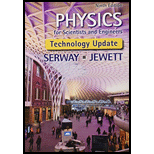
Concept explainers
You unconsciously estimate the distance to an object from the angle it subtends in your field of view. This angle θ in radians is related to the linear height of the object h and to the distance d by θ = h/d. Assume yon are driving a car and another car, 1.50 m high, is 24.0 m behind you. (a) Suppose your car has a flat passenger-side rearview mirror, 1.55 m from your eyes. How far from your eyes is the image of the car following you? (b) What angle does the image subtend in your field of view? (c) What If? Now suppose your car has a convex rearview mirror with a radius of curvature of magnitude 2.00 m (as suggested in Fig. 35.15). How far from your eyes is the image of the car behind you? (d) What angle does the image subtend at your eyes? (e) Based on its angular size, how far away does the following car appear to be?
(a)
Answer to Problem 36.27P
Explanation of Solution
Given info: The height of the following car is
The rear view mirror is flat plane mirror and for the case of plane mirror the object distance is same as the image distance. Therefore the image distance for the following car is same as the car itself.
Hence, the distance of the car from observer eyes as seen through the flat rear view side mirror is,
Here,
Substitute
Conclusion:
Therefore, the image of the car form the observer’s eye is at distance of
(b)
Answer to Problem 36.27P
Explanation of Solution
Given info: The height of the following car is
Formula to calculate the angle subtended by the object,
Here,
For the case of plane mirrors the object height and image height are equal and object distance and image distance are equal. Hence, to find the angle subtended by the image of the following car
Substitute
Conclusion:
Therefore, the angle subtended is
(c)
Answer to Problem 36.27P
Explanation of Solution
Given info: The height of the following car is
Formula to calculate the image distance form a convex mirror for a given object is
Here,
Substitute
Negative
The image distance is negative because the image is formed behind the mirror. Therefore the image distance from the observer’s eye is,
Here,
Substitute
Conclusion:
Therefore, the image of the following car is at
(d)
Answer to Problem 36.27P
Explanation of Solution
Given info: The height of the following car is
From Equation (2) formula to calculate the angle subtended by the image,
Here,
For the case of convex mirrors the object height and image height are not equal.
Formula to calculate the image height is,
Here,
Substitute
From equation (6) and equation (9) respectively, substitute
Conclusion:
Therefore, the angle subtended is
(e)
Answer to Problem 36.27P
Explanation of Solution
Given info: The height of the following car is
Formula to calculate the angle subtended by the image,
Here,
Substitute
Conclusion:
Therefore, the image appears to be
Want to see more full solutions like this?
Chapter 36 Solutions
Bundle: Physics for Scientists and Engineers, Technology Update, 9th Loose-leaf Version + WebAssign Printed Access Card, Multi-Term
- 20. Two small conducting spheres are placed on top of insulating pads. The 3.7 × 10-10 C sphere is fixed whie the 3.0 × 107 C sphere, initially at rest, is free to move. The mass of each sphere is 0.09 kg. If the spheres are initially 0.10 m apart, how fast will the sphere be moving when they are 1.5 m apart?arrow_forwardpls help on allarrow_forwardpls help on thesearrow_forward
- pls help on all asked questions kindlyarrow_forwardpls help on all asked questions kindlyarrow_forward19. Mount Everest, Earth's highest mountain above sea level, has a peak of 8849 m above sea level. Assume that sea level defines the height of Earth's surface. (re = 6.38 × 106 m, ME = 5.98 × 1024 kg, G = 6.67 × 10 -11 Nm²/kg²) a. Calculate the strength of Earth's gravitational field at a point at the peak of Mount Everest. b. What is the ratio of the strength of Earth's gravitational field at a point 644416m below the surface of the Earth to a point at the top of Mount Everest? C. A tourist watching the sunrise on top of Mount Everest observes a satellite orbiting Earth at an altitude 3580 km above his position. Determine the speed of the satellite.arrow_forward
- pls help on allarrow_forwardpls help on allarrow_forward6. As the distance between two charges decreases, the magnitude of the electric potential energy of the two-charge system: a) Always increases b) Always decreases c) Increases if the charges have the same sign, decreases if they have the opposite signs d) Increases if the charges have the opposite sign, decreases if they have the same sign 7. To analyze the motion of an elastic collision between two charged particles we use conservation of & a) Energy, Velocity b) Momentum, Force c) Mass, Momentum d) Energy, Momentum e) Kinetic Energy, Potential Energyarrow_forward
 Principles of Physics: A Calculus-Based TextPhysicsISBN:9781133104261Author:Raymond A. Serway, John W. JewettPublisher:Cengage Learning
Principles of Physics: A Calculus-Based TextPhysicsISBN:9781133104261Author:Raymond A. Serway, John W. JewettPublisher:Cengage Learning Physics for Scientists and Engineers, Technology ...PhysicsISBN:9781305116399Author:Raymond A. Serway, John W. JewettPublisher:Cengage Learning
Physics for Scientists and Engineers, Technology ...PhysicsISBN:9781305116399Author:Raymond A. Serway, John W. JewettPublisher:Cengage Learning University Physics Volume 3PhysicsISBN:9781938168185Author:William Moebs, Jeff SannyPublisher:OpenStax
University Physics Volume 3PhysicsISBN:9781938168185Author:William Moebs, Jeff SannyPublisher:OpenStax Physics for Scientists and Engineers: Foundations...PhysicsISBN:9781133939146Author:Katz, Debora M.Publisher:Cengage Learning
Physics for Scientists and Engineers: Foundations...PhysicsISBN:9781133939146Author:Katz, Debora M.Publisher:Cengage Learning Glencoe Physics: Principles and Problems, Student...PhysicsISBN:9780078807213Author:Paul W. ZitzewitzPublisher:Glencoe/McGraw-Hill
Glencoe Physics: Principles and Problems, Student...PhysicsISBN:9780078807213Author:Paul W. ZitzewitzPublisher:Glencoe/McGraw-Hill College PhysicsPhysicsISBN:9781285737027Author:Raymond A. Serway, Chris VuillePublisher:Cengage Learning
College PhysicsPhysicsISBN:9781285737027Author:Raymond A. Serway, Chris VuillePublisher:Cengage Learning





